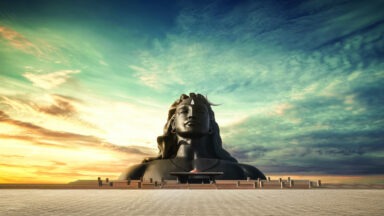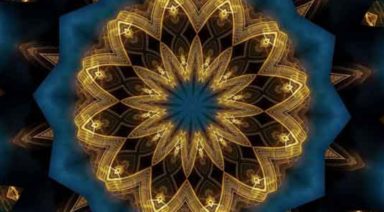Hanuman: A Leap of Love

When I first heard about the mythic monkey Hanuman in my early twenties and his connection to a yoga pose that I had been doing since childhood, I felt a surging happiness to discover that asana was connected to story and mythology. As a lover of mythic consciousness, this catapulted my practice of yoga to a whole new level.
A Call Home to the Heroic Heart
The stories and legends of yoga call us home to our own heroic heart. Each of us is on a hero’s and heroine’s journey undergoing various stages of initiation and alchemical soul growth. The language of the soul is metaphoric and mythic versus rational and linear. Stories are gateways for embodied wisdom to arise within us and help us to navigate the challenges in our lives with curiosity, inquiry and in the spirit of play.
Hanumanasana: A Leap to the Sun
One of the most beloved yoga poses is called hanumanasana, full splits with one leg leaping forward and the other leg stretched back. Visualize leaping over an entire ocean or to the peak of a mountain or even all the way to the Sun. What inner powers must be accessed to take this great leap? This is the story of the mythic monkey named Hanuman and the story of every yogi and yogini too. The full stories of Hanuman are found in the great Indian heroic epic called the Ramayana.
The One with the Broken Jaw
When Hanuman is a baby monkey, he is born with tremendous power since he is the source of Shiva himself and the son of the wind Vayu. One morning, his mother Anjana is out early collecting juicy fruits for her baby when he wakes up. The baby monkey wakes up earlier than normal and is famished for breakfast.
He looks up into the sky and sees a delicious and succulent mango fruit (really the Sun) and takes a bold leap while opening his mouth to swallow the sky fruit.
The Sun cries out to the monkey not to come but Hanuman keeps flying faster than a comet as his hunger is so great. Lord Indra, who rules the kingdom of the Gods and Goddesses, wields his thunderbolt and strikes the monkey down to the earth where he breaks open his jaw, hence the name of Hanuman, “the one with a broken jaw or a broken cheek”. His father Vayu, the wind, is very upset and sweeps up his little son into a cave for him to rest and recover. When Vayu becomes still in the cave and no air circulates through the earth, everything begins to stagnate and die because the air governs the principle of mobility and brings the arousal of the life force.
The Gods and Goddesses convene to figure out a way to restore the world back to life from this massive asphyxiation without prana. They collectively go to the cave with gifts for Hanuman: protection from curses, longevity, spiritual wisdom, ability to cross the ocean, strength of a thunderbolt, immunity from burning fire, capacity to become very small or very large, abundance of happiness and contentment, speed of the wind and even freedom from death itself. Vayu is pleased and releases prana back into the world. Hanuman wakes up with his new powers and being a mischievous monkey, he wants to play and ends up wreaking havoc in the rituals of the sages. And so he is cursed to forget his powers until someone reminds him.
Devotion to the Sun
A little later in life, his spiritual hunger begins to awaken and he wants to study with the Surya the Sun. The Sun denies him based on their first meeting but Hanuman persists because he wants to learn the mantras. The Sun states that he is busy and sweaty all day long carrying the chariot of sunlight across the earth and doesn’t the time to teach a monkey. Hanuman says he will run backwards in front of the Sun from dawn to dusk and will be a most devoted student. Their relationship deepens and when Hanuman asks to pay his teacher the “guru dakshina”, the Sun refuses and says the payment was in his dedication. Hanuman insists that he wants to pay something to the Sun and so he is asked to protect the spiritual son of the Sun on the earth by the name of Sugriva, whom Hanuman will meet later in his life once living deep in the forest.
The Hero’s Journey through the Myth of Hanuman
This is the beginning of the tales of Hanuman and the beginning of the spiritual path for so many yogis. When hearing the great myths of yoga, ask how every character in the story is part of the self and how the myth lives inside the psyche. A hero’s journey is filled with initiations, tests, trials, ordeals and resistances which all become food for the soul’s growth. Imagine that you are Hanuman with the Sun as the light of your heart and the illumination of your mind. At first glance, you do not see the real truth of your own self and with full gusto pursue the outer forms of hunger in life without a spiritual anchor. Perhaps the hero is reaching for fame, money, power, recognition or any number of allurements but without a real ground in the spiritual soil of the heart. You are knocked down into your first initiation and it becomes a dark night of the soul, where life seems to have no meaning and everything plunges into an inner death-like state.
Every true hero must navigate the innermost terrain of the psyche and eventually learn how to listen in the stillness from within.
As the yogic hero takes refuge in the cave of the heart, great gifts and boons are bestowed and the hero re-emerges as MahaVira, “the great heroic heart”, one of Hanuman’s main names.
Transformation Through Mantra
From the first deadly fall, there is a waking up of consciousness and a vigorous spiritual appetite begins to grow. This is the nature of Hanuman’s second leap to the Sun when he wishes to learn from Surya, the spiritual master of mantra and yoga. The learning curve of the individual consciousness is greatly accelerated and Hanuman is initiated into the transformative practice of mantra. The thunderbolt of Lord Indra that struck Hanuman to the earth with a broken jaw was really the first initiatory stage into mantra yoga.
The power of the mouth to open with the chanting of mantra becomes the healing bridge between the mind and the heart of the yogi. The mind becomes illuminated and the heart filled with true light.
Throughout the Ramayana, Hanuman will be called into action to make bold leaps in service to Ram and Sita, who represent dharma and unconditional love. He is the embodiment of pure devotion and humility. He successfully makes every leap possible because of his inner strength and his remembrance of Ram & Sita. There will be times when he forgets his powers and must be reminded of what he is capable of just as every hero encounters doubt, fear and disbelief.
In the hero’s journey of life, there are confrontations with fear and death in order to cross each new threshold, seize the sword of sovereignty and eventually return to the world with the gifts of the Self in service to the greater whole of humanity.
Find Your Great Heroic Heart
Every yogi is called to be their own “Great Heroic Heart” and the tail and tale of Hanuman can endlessly inspire the Bhakti (devotion and love) practices of yoga. May we remind each of our true power and humbly receive the remembrance from our friends when we feel like we are failing or that something is impossible. Let’s chant and sing the mantras of awakening and feel our soul remembering why we are here on this Earth together to live our dharma and to leap with love.
Hanuman Festival
If you love the story of Hanuman, immerse yourself in a community of devotion at the Hanuman Festival, every June, in Boulder, Colorado, a music-filled yoga festival at the foot of Colorado’s Rocky Mountains, with world-class yoga instructors. It’s an annual invitation to “immerse yourself in body, mind and heart as you relax and rejuvenate, dance and devote, connect and expand, have fun and just be.”
Photo credit: Moni Versano
Ridding Your Negative Personal Narratives With Lord Shiva

Lord Shiva is a well-known and worshipped Hindu deity. He is one of the Holy Trinity (the Trimurti), which consists of Lord Brahma, Lord Vishnu, and Lord Shiva. What each represents in our familiar terms are brand new beginnings (Brahma), the middle of everything in existence (Vishnu), and the endings (Shiva). When Shiva, as the Lord of Dissolution, gives us the endings, he also provides the space for Brahma to instill a bright new beginning. It is from the void of nothingness, or space, left after something comes to an end, that Brahma responds by bringing the start of something new.
Shiva, Lord of Dissolution
Shiva, The Auspicious One, is also known as Mahadeva or The Great God. He is worshipped as the Supreme Being in Shaivism, a major institution within Hinduism. I like to explain the concept of endings giving way to brighter new beginnings with the metaphor of a bookshelf filled with storybooks that represent our own considerations about ourselves.
Imagine you have a large bookshelf in your mind. The bookshelf is jam-packed with books whose titles represent your own self-judgments or concepts of yourself. One thing to mention is that we are constantly in judgment of ourselves. We are usually in judgment of something and judgments can be good or bad. For instance, we might see a book entitled ‘I am a great Mother,’ or ‘I am a giving person.’
Conversely, we have the debilitating narratives. ‘I am unworthy’ or ‘I am not flexible enough’ as some of the titles we’re experiencing. But the debilitating narratives are simply opportunities to grow or bring Shiva into our lives.
Shiva comes along as the Lord of Dissolution; he shows us where we are hindering our growth with certain stories or ways of being. For instance, when you decide you are fed up with thinking of yourself as unworthy, or not good enough, Shiva gives you the willpower to dissolve that story. The ‘I am unworthy’ book gets removed from the shelf and thrown to the wayside.
What is left behind is an open space, an open space ready and willing to house a new book with a new title. Brahma steps in and gives us the capacity to formulate a new storybook title that feels brighter and shinier as a new beginning, or judgment of self. For example, we switch from the ‘I am unworthy’ mantra to ‘I am good enough.’ In this way, Shiva and Brahma give us the ability to challenge our belief system and change it for self-betterment.
Shiva, Lord of Dance
A common depiction of Shiva is one of a dancing four-armed deity. In this form, Shiva is known as Nataraja, or the Lord of Dance. He is seen dancing in a halo of fire which represents samsara, or ‘flowing around.’ In his upper right hand, Shiva holds a hand drum said to have drummed the first drum beats to help create everything, paired with the sound of “Om.”
His upper left hand holds a flame said to have the ability to destroy on behalf of transformative new beginnings. His bottom lower right hand holds abhayamudra, a gesture used to convey fearlessness. His bottom left hand mimics the lifted position of his left leg. This symbolizes a respite soul’s find from the earthly troubles on a path towards soul liberation. His lifted left leg is a journey towards this elevated consciousness. Finally, the snake he wears around his waist is the creative energy that exists in our psychic body.





































